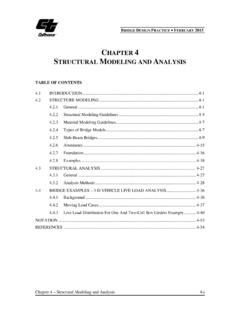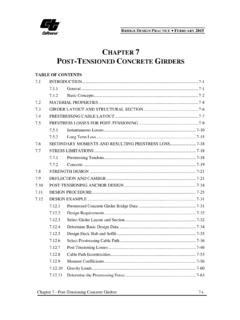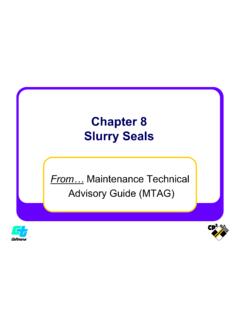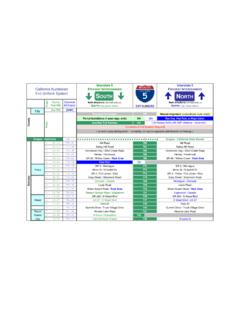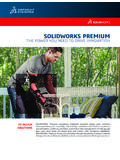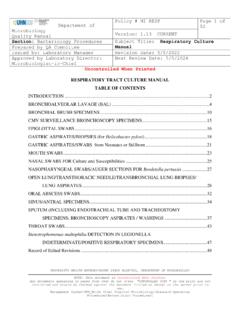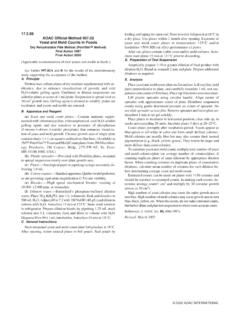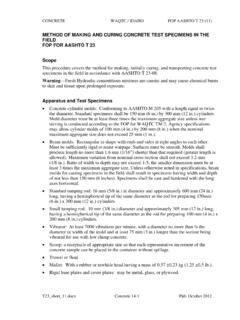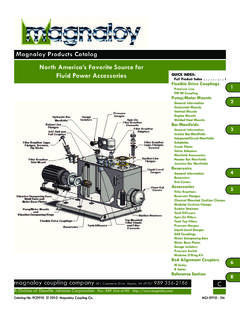Transcription of METHOD OF TEST FOR FLEXURAL STRENGTH OF CONCRETE
1 C. APPARATUS 2. b. California Test 523 July 2012 STATE OF CALIFORNIA BUSINESS, TRANSPORTATION AND HOUSING AGENCY DEPARTMENT OF TRANSPORTATION DIVISION OF ENGINEERING SERVICES Transportation Laboratory 5900 Folsom Blvd. Sacramento, California 95819-4612 METHOD OF TEST FOR FLEXURAL STRENGTH OF CONCRETE This test METHOD describes the procedure used for determining the FLEXURAL STRENGTH of CONCRETE by two different methods: METHOD 1, a simple beam with center-point loading, and; METHOD 2, a simple beam with third point loading. Both tests are intended to be used to determine modulus of rupture and are considered to give equivalent answers. California Test 539 - Sampling Fresh CONCRETE ASTM E 4 - Force Verification of Testing Machines ASTM C 78/C 78M - FLEXURAL STRENGTH of CONCRETE (Using Simple Beam with Third Point Loading) ASTM C 2 93/C 293M - FLEXURAL STRENGTH of CONCRETE (Using Simple Beam with Center Point Loading) Testing Machine: The testing machine shall conform to the requirements of Sections 16, 17, and 18 of ASTM E 4.
2 Hand operated testing machines having pumps that do not provide a continuous loading in one stroke shall not be permitted. Motorized pumps or hand-operated positive displacement pumps having sufficient volume in one continuous stroke to complete a test without requiring replenishment are permitted and shall be capable of applying loads at a uniform rate without shock or interruption. The loading device shall employ bearing blocks, which will ensure that forces applied to the beam will be perpendicular to the face of the specimen and applied without eccentricity. Beam molds: Molds shall be made of steel, cast iron, or other nonabsorbent material and be nonreactive with CONCRETE containing portland or other hydraulic cements. Molds shall maintain their dimensions and shape under conditions of severe use. c. Molds shall be mortar tight during use. A suitable sealant, such as sealing caulk, heavy grease, modeling clay, or microcrystalline wax shall be used where necessary to prevent leakage through the joints.
3 D. Positive means shall be provided to hold base plates firmly to the molds. Molds shall be lightly coated with mineral oil or another suitable nonreactive release material before use. e. The molds shall be 6 in. 6 in. in cross section and a minimum of 32 in. in length for METHOD 1, and a minimum of 20 in. in length for METHOD 2. f. The surface of the molds shall be smooth and free from blemishes. g. The sides, bottom, and ends shall be at right angles to each other and shall be straight and true and free of warping. h. Maximum variation from the nominal cross section shall not exceed 1/8 in. D. TERMINOLOGY 1. Tamping rod: a round, straight steel rod with a diameter of 5/8 in. 1/16 in. and length of at least 4 in. greater than the depth of the measure in which rodding is to be performed, but not more than 24 in.
4 One or both ends of the tamping rod must be rounded to a hemispherical tip of the same diameter as the rod. 2. Small tools: Items such as shovels, scoops, pails, trowels, wooden floats, rubber hammers, and sponges. E. CALIBRATION OF APPARATUS 1. METHOD 1 Beam Breaking Machine. The beam breaking machine applies a load at the midpoint of a 30 in. span by means of a gage-equipped hydraulic jack. The gage is subject to error and must be calibrated before use on each project. The calibration can be made by using a calibrated compression testing machine in the district laboratory. a. Place the jack in the compression testing machine in the same (inverted) position in which it is used in the beam testing machine. b. Apply the load by turning the crank of the jack; do not apply load by operating the compression testing machine. c.
5 Record the corresponding reading on the compression testing machine indicator as the needle of the gage reaches each 1,000 lb increment. d. Attach a table to the jack showing the correction to be applied to each 1, 000 lb increment of gage reading and include date of calibration on the table. Make up this table so that a plus correction will indicate the amount to be added to the observed gage reading and a minus correction will indicate the amount to be subtracted. e. Calif ornia Test 523 July 2012 Send jacks in to the Transportation Laboratory, Structural Materials Testing Branch for adjustment if they are found to be in error by more than 500 lb at any point. -2-California Test 523 July 2012 1.
6 A. b. c. d. 2. a. b. c. d. 3. a. b. c. 2. METHOD 2 Beam Breaking Machine. Calibrate the beam breaking machine in accordance with the manufacturer s recommended procedure or ASTM E 4 at least once every 12 months. F. PREPARATION OF TEST SPECIMENS Sampling fresh CONCRETE : Obtain a sample of CONCRETE from the mass during the placing operation (see California Test 539). Transport samples in watertight containers to the place where the test specimens are to be molded. If any of the aggregate used is retained on the 1 in. sieve, screen the CONCRETE sample through a 1 in. sieve and discard the oversize aggregate. Always remix the sample with a shovel on a nonabsorbent surface to assure that there is no segregation of the coarse aggregate or mortar. Molding test specimens: Before each use, apply a release agent such as a light coat of fresh oil to all inside surfaces of the mold.
7 Place CONCRETE in the molds in two approximately equal layers. Rod each layer 60 times for 20 in. beams or one stroke for each 2 sq. in. of surface. Do not stroke the bottom of the mold with the rod. For the second layer, rod in. into the first layer. Tap the sides of the mold lightly with a rubber mallet to close the voids. Spade the CONCRETE along the sides and ends of the beam molds with a trowel or other suitable tool to remove air voids. Strike off surplus CONCRETE and finish the surface with a wood float. Finish with the minimum manipulation necessary to provide a flat, even surface that is level with the rim or edge of the mold. Curing test specimens: Place earth or sand around the sides and ends of the molds to prevent excessive loss of the heat generated by cement hydration in the CONCRETE . Apply the same curing medium to the top surface of the test beam as is applied to the pavement.
8 If application of the specified curing medium is delayed, cover the beam immediately with a double thickness of burlap or other fabric, which shall be kept thoroughly damp until the membrane is applied. At the end of approximately 24 hr , remove the mold and transport the beam resting on its base plate to the curing location. -3-Carefully remove the beam from the base plate and bury the beam in damp earth or sand with at least 4 in. of cover. Bury beams on Saturday that are cast on Friday. Keep the earth or sand surrounding the test beams damp at all times, and cover with a tarpaulin or sisal kraft paper to prevent the cooling effect of excessive evaporation. Place test specimens in a saturated-lime water bath 24 hr 6 hr before testing. The saturated-lime water bath shall be 73 F 9 F. Store the specimens in the saturated-lime water bath until the time of testing.
9 NOTE: Keep the beams thoroughly damp throughout the curing period. Even a few minutes exposure of beams to drying can seriously affect the test STRENGTH . BEAM BREAKING METHOD 1 Procedure: Position the testing machine on a firm foundation well removed from the influence of jars and vibration caused by passing traffic. Brush the beam clean. Turn the beam on its side, with respect to its position as molded, and place it in the breaking machine. Set the bearing plates square with the beam and adjust for distance by means of the guide plates furnished with the machine. Place a strip of leather or similar material under the upper bearing plate to assist in distributing the load. Bring the plunger of the jack into contact with the ball on the bearing bar by turning the screw in the end of the plunger. After contact is made and when only firm finger pressure has been applied, adjust the needle on the dial gage to 0.
10 Apply about 400 lb of force with the lever pump to seat the beam firmly in its supports and then remove the guide plates. Always remove the guide plates before proceeding further with the test. Retract the screw pump to its outer limit by turning the crank in a counterclockwise direction. While doing this, avoid drawing air into the cylinder of the screw pump, maintain about 400 lb of force on the gage by manipulating the lever pump. Turn the handle of the screw pump in a clockwise direction at a rate such that the gage reading increases at a rate of 600 to 800 lb/min. Continue turning the screw pump handle until the beam breaks, and record this maximum load in pounds as value of P1. Calculations - METHOD 1 -4-Apply the correction indicated on the calibration table that is attached to the jack (see Section ) to P1, and record this corrected load in pounds as the value of P.
